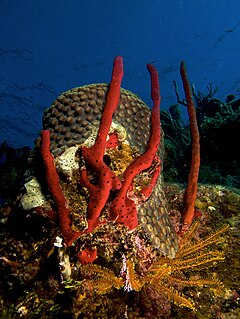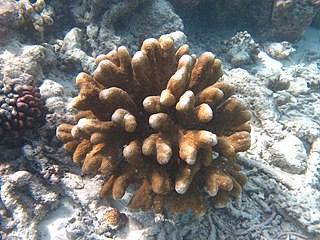
Sponges, the members of the phylum Porifera, are a basal Metazoa (animal) clade as a sister of the Diploblasts. They are multicellular organisms that have bodies full of pores and channels allowing water to circulate through them, consisting of jelly-like mesohyl sandwiched between two thin layers of cells. The branch of zoology that studies sponges is known as spongiology.

A coral reef is an underwater ecosystem characterized by reef-building corals. Reefs are formed of colonies of coral polyps held together by calcium carbonate. Most coral reefs are built from stony corals, whose polyps cluster in groups.

The crown-of-thorns starfish, Acanthaster planci, is a large starfish that preys upon hard, or stony, coral polyps (Scleractinia). The crown-of-thorns starfish receives its name from venomous thorn-like spines that cover its upper surface, resembling the biblical crown of thorns. It is one of the largest starfish in the world.

Coralline algae are red algae in the order Corallinales. They are characterized by a thallus that is hard because of calcareous deposits contained within the cell walls. The colors of these algae are most typically pink, or some other shade of red, but some species can be purple, yellow, blue, white, or gray-green. Coralline algae play an important role in the ecology of coral reefs. Sea urchins, parrot fish, and limpets and chitons feed on coralline algae. In the temperate Mediterranean Sea, coralline algae are the main builders of a typical algal reef, the Coralligène ("coralligenous"). Many are typically encrusting and rock-like, found in marine waters all over the world. Only one species lives in freshwater. Unattached specimens may form relatively smooth compact balls to warty or fruticose thalli.
Skeletal eroding band (SEB) is a disease of corals that appears as a black or dark gray band that slowly advances over corals, leaving a spotted region of dead coral in its wake. It is the most common disease of corals in the Indian and Pacific Oceans, and is also found in the Red Sea.

Amphimedon compressa, the erect rope sponge, red tree sponge, red tubular sponge, or red sponge is a demosponge found in southern Florida, the Caribbean Sea, and the Bahamas. It can be deep red, orange, brown, or black.
Mycale grandis, the orange keyhole sponge, is a species of marine demosponge in the family Mycalidae. Mycale is a large genus and this species is placed in the subgenus Mycale making its full name, Mycale (Mycale) grandis.

Umimayanthus parasiticus, commonly known as the sponge zoanthid, is a species of coral in the order Zoantharia which grows symbiotically on several species of sponge. It is found in shallow waters in the Caribbean Sea and the Gulf of Mexico.

Siderastrea siderea, commonly known as massive starlet coral or round starlet coral, is a stony coral in the family Siderastreidae. It is found in shallow parts of the western Atlantic Ocean as solid boulder-shaped or domed structures.
Agelas schmidti, commonly known as the brown tubular sponge, is a species of demosponge. It occurs at moderate depths in the Gulf of Mexico and the Caribbean Sea and often has a colonial coral growing over the surface. The type locality is Puerto Rico.

Colpophyllia is a genus of stony corals in the family Mussidae. It is monotypic with a single species, Colpophyllia natans, commonly known as boulder brain coral or large-grooved brain coral. It inhabits the slopes and tops of reefs, to a maximum depth of fifty metres. It is characterised by large, domed colonies, which may be up to two metres across, and by the meandering network of ridges and valleys on its surface. The ridges are usually brown with a single groove, and the valleys may be tan, green, or white and are uniform in width, typically 2 centimetres. The polyps only extend their tentacles at night.
Cymo melanodactylus, the furry coral crab, is a species of small decapod crustacean in the family Xanthidae. It is found in the Indo-Pacific Ocean and lives in crevices and on the surface of corals in the genus Acropora.

Isopora palifera is a species of stony coral in the family Acroporidae. It is a reef building coral living in shallow water and adopts different forms depending on the water conditions where it is situated. It is found in the Western Indo-Pacific Ocean as far east as Australia.

Acropora millepora is a species of branching stony coral native to the western Indo-Pacific where it is found in shallow water from the east coast of Africa to the coasts of Japan and Australia.
A Mesophotic Coral Reefs or Mesophotic Coral Ecosystem (MCE), originally from the latin word meso meaning middle and photic meaning light, is characterised by the presence of both light dependent coral and algae, and organisms that can be found in water with low light penetration. Mesophotic Coral Ecosystem (MCEs) is a new widely adopted term use to refer mesophotic coral reefs that contrasting other similar terms like "deep coral reef" and "twilight zone", since those terms sometimes so confusing due to a lot of intercept between them.

Alcyonium coralloides, commonly known as false coral, is a colonial species of soft coral in the family Alcyoniidae. It is native to the northeastern Atlantic Ocean and the Mediterranean Sea. In the former location it generally grows as sheets or small lobes but in the latter it is parasitic and overgrows sea fans.
Carijoa riisei, the snowflake coral or branched pipe coral, is a species of soft coral in the family Clavulariidae. It was originally thought to have been native to the tropical western Atlantic Ocean and subsequently spread to other areas of the world such as Hawaii and the greater tropical Pacific, where it is regarded as an invasive species. The notion that it is native to the tropical western Atlantic was perpetuated from the fact that the type specimen, described by Duchassaing & Michelotti in 1860, was collected from the US Virgin Islands. It has subsequently been shown through molecular evidence that it is more likely that the species is in fact native to the Indo-Pacific and subsequently spread to the western tropical Atlantic most likely as a hull fouling species prior to its original description.
Gelliodes wilsoni, sometimes known as the gray encrusting sponge, is a species of sponge found in shallow water in the Philippines. It was first described in 1925 by the American zoologist Edmund Beecher Wilson, the type locality being North Sulawesi. He gave it the name Gelliodes fibrosa, a name already used in 1905 for a species in the Gulf of Mannar, Sri Lanka. In 2013, Carballo, Aquilar-Camacho, Knapp & Bell, decided that this was a homonym, a separate taxon from the original one given that name, and gave the new species the name Gelliodes wilsoni.

Clathria aceratoobtusa is a species of sponge in the family Microcionidae. The genus Clathria is subdivided into a number of subgenera, and it is in the subgenus Microciona. It is native to shallow water habitats in the Indo-Pacific region. The type locality is the Gulf of Thailand.

Porites lutea is a species of stony coral in the family Poritidae. It is found growing in very shallow water on reefs in the Indo-Pacific region. It sometimes forms "microatolls" in the intertidal zone and these massive structures have been used to study trends in sea levels and sea water temperature.












